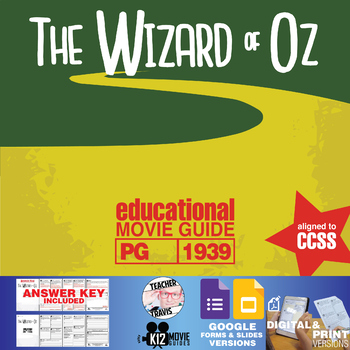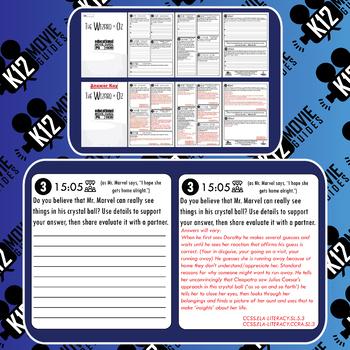The Wizard of Oz Movie Guide | Worksheet | Questions | Google Slides (PG - 1939)
- Zip
- Google Apps™

What educators are saying
Also included in
- This classic musicals movie guide bundle is great to have in your emergency fun toolkit for ELA/Music substitutes or supplemental material for your class.Check the preview files for each individual product to see high resolution sample questions and decide if these guides are suitable for your studePrice $25.79Original Price $39.92Save $14.13
Description
The Wizard of Oz Movie Guide | Worksheet | Questions | Google Slides (PG - 1939) challenges students to put themselves in the shoes of the characters and learn personal lessons from their journeys. Discuss what each character is missing, how they prove they actually already have it, and the advice they each get from the mystical Wizard of Oz. Analyze song lyrics and determine if the Wizard of Oz is fond of alliteration.
Check the preview file for high resolution sample questions to see if this movie guide is suitable for your students. This resource consists of 12 high-level, short answer reflection and essay questions that will do more than just ask your students to regurgitate information.
★You're In Good Hands★
Although this movie guide doesn't have many ratings yet, please don't be overly concerned as it was posted more recently than my other resources. Please visit MY STORE to see over 5,000 ratings with a ★★★★★ average.
This product includes:
- A student movie guide, PDF print version (4 pages)
- A student movie guide, PDF digital fillable form version (4 pages)
- A Google Slides Version of the Movie Guide
- An answer key (4 pages) IS included with this movie guide, however many answers will vary as students are encouraged to construct their own meaning from the characters' dialogue and behavior.
- A generic movie guide permission slip (1 page)
- CCSS alignment indicating standards met, PDF (1 page - see also preview image)
- CCSS Note: I’ve taken the liberty of aligning certain reading standards with the act of consuming content via the movie instead. Although students aren’t reading they are asked to perform the same cognitive functions on the content that they consumed from the movie.
Do you teach a film literature or analysis elective class?
A version of this movie guide is now featured in a full Film Literature Curriculum. Check it out on CurricuLimb's TPT store here : )
Google Classroom Distance Learning Tips:
- Create an assignment using the Google Form
- Use the screen sharing tool on your conference calling software to play the movie
- Pause the movie at each question to give students time to write/discuss
- Make sure students input their name, so when you open your copy of the form, you can see each student's individual response they submitted
- Note: If you are using the movie guide for multiple classes and want to separate
- responses by class, create multiple copies of the google form with file names such as [Title]MovieGuideClassPeriod[2] and then create assignments for each copy of the Google Form movie guide
General Tips for Using this Movie Guide:
- Print one, double-sided movie guide for each student
- Preview the next question on the movie guide as you complete each one, this can help students pay attention to important upcoming events.
- Pause at the times designated on the movie guide, encourage students to debate, discuss and talk about their ideas before writing their answers.
- Discourage students from simply copying answers.
- Randomly choose a student to share their answer and defend it if necessary.
- If time allows, feel free to rewind and show important parts of the movie again for additional analysis.
- After completing the short answers, allow 5-10 minutes for each essay question at the end of the film.
- On average, this movie guide will require about 45-60 minutes in addition to the length of the movie.
Digital PDF Version Tips
- It is intended for a paperless, 1:1 tablet/iPad classroom
- Ask students to download a PDF editor app if they don't already have one. It needs to have a save function as well. I used Foxit PDF.
- Host the file. I used google drive to share a folder with students.
- When complete, ask students to save the file in a designated google drive folder using a naming convention. (I use LastnameFirstnameMovieGuide.pdf)
Get Free Money with TPT Credits!
- Leave Feedback for this product and earn TPT credits
- 20 Credits = $1 OFF any TPT purchase
FREE Movie Guides & Resources:
Get a feel for my work and see if this resource is right for you. I ask questions that require students to 'live' on the higher levels of Bloom's taxonomy.
- Free Onward Movie Guide (PG - 2020)
- Free Trolls World Tour Movie Guide (PG - 2020)
- Free Kung Fu Panda 3 Movie Guide (PG - 2016)
- Free The Lightning Thief Movie Guide (PG - 2010)
- Free Home Alone 2 Movie Guide (PG - 1992)
- Free! Story Elements Worksheet
- Free! Character Analysis & Comparison
Your feedback, ratings, likes and follows are appreciated:
- TpT Store - TeacherTravis
- Pinterest - TeacherTravis
- Instagram - Teachers Travis
- Facebook - K12MovieGuides
- Twitter - K12MovieGuides
- Blog & Website - K12MovieGuides
See my movie guides below, by category, or search for one at my TPT STORE






